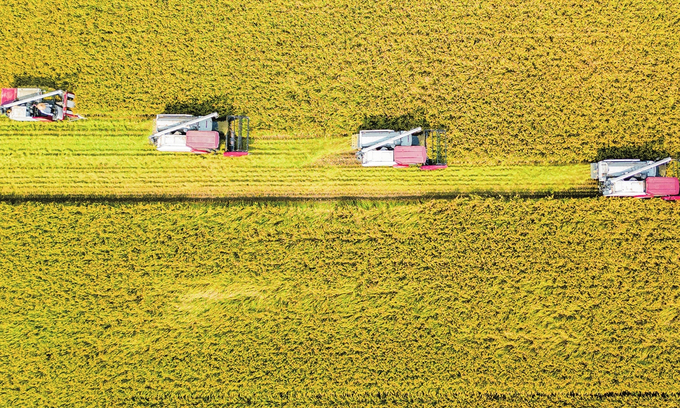June 12, 2025 | 02:35 GMT +7
June 12, 2025 | 02:35 GMT +7
Hotline: 0913.378.918
June 12, 2025 | 02:35 GMT +7
Hotline: 0913.378.918

As seen from above, local farmers harvest rice at a farm in Hai'an, East China's Jiangsu Province on October 24, 2023. Photo: cns
The continuous bumper harvests, together with the ongoing optimization of the crop variety structure and abundant grain reserves, have guaranteed the country's food security, Chinese officials said on Tuesday.
China's per capita grain resources exceed 490 kilograms, which is above the international food security threshold of 400 kilograms per capita, Chen Bangxun, director of the Development and Planning Department of the Ministry of Agriculture and Rural Affairs (MOA), said at a press conference.
China has continuously optimized its grain variety structure, Chen said, noting that the annual production of basic food crops consistently exceeds demand, ensuring absolute security. Supplies of high-quality rice and specialty wheat have increased.
Corn, which saw a significant increase in demand, also witnessed a rise in production, leading to a noticeable improvement of the supply-demand situation. The expansion of soybean cultivation has shown significant progress, further enhancing the country's self-sufficiency level in this crop, Chen said.
China's grain reserves remain abundant. The grain reserve-to-consumption ratio far exceeds the safety level of 17 to 18 percent proposed by the UN Food and Agriculture Organization, he noted.
Last year, China's total grain output reached a record high of 1.39 trillion jin, an increase of 1.3 percent over the previous year, data from the ministry showed. It has remained stable at more than 1.3 trillion jin for nine consecutive years.
As one of China's major agricultural regions, East China's Shandong Province recently announced achievements in "three increases" - expanding the sowing area, improving per unit yields and reporting an overall increase in production.
The total grain output of Shandong stood at 113.11 billion jin in 2023, up 2 percent year-on-year. In recent years, China has enhanced efforts in protecting and developing arable land, as well as stabilizing sowing areas. These efforts have yielded consistent results, laying a solid foundation for food security, Li Guoxiang, a research fellow at the Rural Development Institute of the Chinese Academy of Social Sciences, told the Global Times on Tuesday.
The soybean planting area in China reached 157 million mu (10.47 million hectares) in 2023. The areas under cultivation yielded record-high output of 41.68 billion jin in 2023. The planting area of oilseed crops exceeded 200 million mu, per data from the MOA.
In terms of food security in the future, Li suggested a more detailed approach. For instance, he proposed differentiation based on different varieties, with a focus on improving the quality of basic food crops while emphasizing boosting yields for feed crops. "There is still growth potential in the production of crops such as corn and soybeans," Li said.
Strategically supplementing scarce varieties in production gaps with international sources, and improving the structure of varieties, also played a crucial role in ensuring the supply and stabilizing the prices of grain, Chen noted.According to data from the General Administration of Customs, China imported 160 million tons of grain in 2023, up 11.7 percent year-on-year.
China has been actively involved in the international agricultural market. The country's agricultural product imports rank first globally, making it the world's largest market for agricultural products, Chen noted.
On the export front, China holds the fifth position globally, with high-quality products such as fruits, vegetables and aquatic products shipping into the international markets. In 2023, China's agricultural exports reached $98.93 billion, marking a 0.9 percent increase from the previous year, Chen said.
(Global Times)

(VAN) As of Friday, a salmonella outbreak linked to a California egg producer had sickened at least 79 people. Of the infected people, 21 hospitalizations were reported, U.S. health officials said.

(VAN) With the war ongoing, many Ukrainian farmers and rural farming families face limited access to their land due to mines and lack the financial resources to purchase needed agricultural inputs.

(VAN) Vikas Rambal has quietly built a $5 billion business empire in manufacturing, property and solar, and catapulted onto the Rich List.

(VAN) Available cropland now at less than five percent, according to latest geospatial assessment from FAO and UNOSAT.

(VAN) Alt Carbon has raised $12 million in a seed round as it plans to scale its carbon dioxide removal work in the South Asian nation.

(VAN) Attempts to bring down the price of the Japanese staple have had little effect amid a cost-of-living crisis.

(VAN) Fourth most important food crop in peril as Latin America and Caribbean suffer from slow-onset climate disaster.